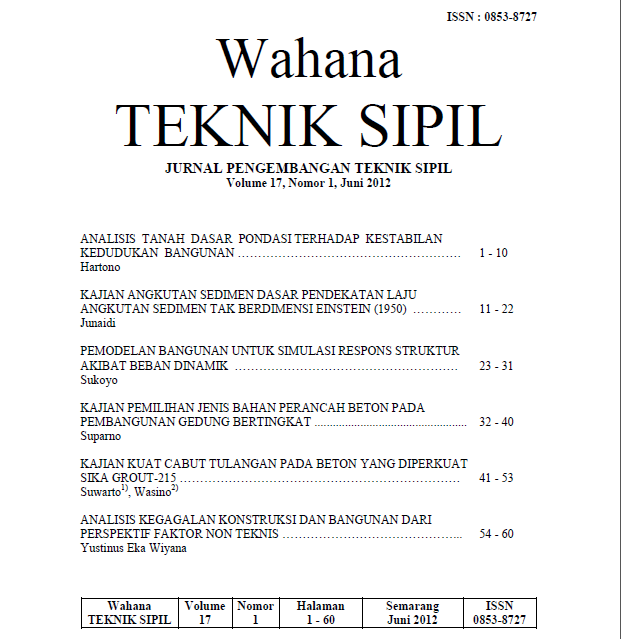Kajian Kuat Cabut Tulangan Pada Beton Yang Diperkuat Sika Grout-215
DOI:
https://doi.org/10.32497/wahanats.v17i1.113Keywords:
Sika Grout-215, Anchor length, Anchor shape.Pull Out, Bound StressAbstract
Sika-215 Grout is ready grouting material that has multiple features have expanded properties and very easy in use, that is just simply add water with a specific ratio. Many application are already using this material for purposing of anchorage bolts, precast concrete connections, but more broadly-215 sika grout can be used for machine foundations, column base plates, foundation support a bridge, and so on. The purpose of this study to determine how many influence the shape and length of anchorage against strong pull between the anchor-reinforced concrete grout Sika 2l5. Specimens in this study a concrete cube 15x15x15 cm 2 for the strong pull and testing of concrete cylinders with a diameter of 15cm, a height of 30 cm for the characteristic compressive strength testing, the concrete mix design based on the K-225 at 28 days, while the iron anchor used is concrete screw diameter of 16 mm. The results showed that the long form of anchor and anchoring to the real effect of the strong pull Out force is generated. With a surface area of 225 cm2 test piece, grout Sika grouting material 215 provides a powerful pull an average of 6834 ton maximum length that occurs in the form of anchoring 14cm straight (type-a, and 6 cm diameter hole grouting.
Downloads
Published
Issue
Section
License
Authors who publish with this journal agree to the following terms:Authors retain copyright and grant the journal right of first publication with the work simultaneously licensed under a Creative Commons Attribution License that allows others to share the work with an acknowledgement of the work's authorship and initial publication in this journal.
Authors are able to enter into separate, additional contractual arrangements for the non-exclusive distribution of the journal's published version of the work (e.g., post it to an institutional repository or publish it in a book), with an acknowledgement of its initial publication in this journal.
Authors are permitted and encouraged to post their work online (e.g., in institutional repositories or on their website) prior to and during the submission process, as it can lead to productive exchanges, as well as earlier and greater citation of published work (See The Effect of Open Access).






